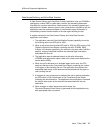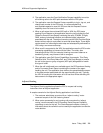
ASAI and Supported Applications
2-10 Issue 7 May 1998
3. The application selects the route for the call based on the call information
passed and/or agent availability and sends a Route Select Capability with
the route destination.The ECS then routes the call as indicated by the
application.
4. When the call is delivered to the destination, the ECS sends a Route End
Capability indicating a successful route. If the call cannot be routed to the
specified destination, the reason for failure is returned to the application.
ASAI applications may use a variety of criteria for routing a call. Such criteria may
be based on:
■ Information received with an incoming call:
—CPN/BN
— DNIS
— II-Digits
— UUI
— Flexible Billing
■ Information collected from the caller:
— using Call Prompting on the ECS
— using CINFO (collected from the caller)
— using ASAI Request Digit Collection
■ Information provided by the ECS at route request time:
— VDN used to access vector
■ a combination of the above-provided information
Information Sources for Routing
■ CPN/BN is obtained from incoming ISDN/PRI and R2MFC trunk calls.
■ DNIS is obtained from incoming ISDN/PRI trunk calls.
■ II-Digits is obtained from incoming ISDN/PRI trunk call when the network
provides it. The digits contain information about the caller and can be used
in adjunct routing applications to route calls.
■ UUI is obtained on ISDN/PRI trunk calls when provided by the network.
Like II-Digits, this information is caller-related. Unlike II-Digits, the contents
of UUI are more flexible. Any kind of information (for example, credit card
number, PIN, etc.) may be passed as UUI. This information is generated
with the call on the local ECS or to a destination on a remote ECS. UUI
information may be sent by the network or by an ASAI application.
■ Flexible Billing is obtained on an incoming ISDN/PRI trunk and is used to
inform the application if Flexible Billing is available on an incoming call.
This information can be used as part of the criteria for routing a call.


















